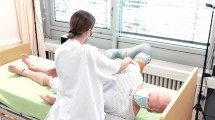Abstract
Moving a patient between a bed and a wheel-chair is one of the most burdensome nursing-care tasks for caregivers. Various kinds of transfer assistant robots have been proposed previously. However, designing comfortable transfer motions for individuals has not been intensively studied due to the difficulty of modeling such physical human-robot interactions in conjunction with user preference. To lift a patient from a bed, a robot should raise the patient’s body from the supine posture to a holding posture. In this research, we proposed two different methods for generating lifting motions comfortable for users: (1) a model-based method for estimating the holding posture, and (2) a model-free method based on Bayesian optimization for generating the raising motion. A comfortable holding posture can be generated using human-robot interactive models by reducing the load and pain sensation in simulation, without user trials. To reduce the load, a musculoskeletal model is developed to estimate muscle force considering human-robot physical interactions. To reduce pain, a softness distribution model of the human body is also created to control the robot to contact the human body at a softer place. The motion for raising the human body from the supine posture to the estimated holding posture can be generated with the model-free method from the user’s feedback (scalar value) in terms of the comfort level. Using Bayesian optimization, the number of required trials with physical interactions between user and robot can be reduced to ease the user’s burden. To verify the effectiveness of the proposed methods, we conducted experiments with a dual arm robotic system and human subjects. We search for the most comfortable holding posture based on the developed human models and compare it with the measured value of subjects in the experiment. To generate the raising motion, the experimental result shows that our method can optimize a user-comfortable care motion controller for each individual efficiently.










Similar content being viewed by others
References
Delp, S.L., Anderson, F.C., Arnold, A.S., Loan, P., Habib, A., John, C.T., Guendelman, E., Thelen, D.G.: Opensim: open-source software to create and analyze dynamic simulations of movement. IEEE Trans. Biomed. Eng. 54(11), 1940–1950 (2007)
de Zee, M., Rasmussen, J., Lem, J., Siebertz, K.: Computer simulation of the active motion system with musculoskeletal models. SAE Trans. J. Passeng. Cars Electron. Electr. Syst. 272–278 (2005)
Ding, M., Ikeura, R., Mukai, T., Nagashima, H., Hirano, S., Matsuo, K., Sun, M., Jiang, C., Hosoe, S.: Comfort estimation during lift-up using nursing-care robot - RIBA. In: 2012 First International Conference on Innovative Engineering Systems (ICIES). Alexandria, Egypt (2012)
Guizzo, E., Goldstein, H.: The rise of the body bots. IEEE Spectr. 42(10), 50–66 (2005)
Hayashi, T., Kawamoto, H., Sankai, Y.: Control method of robot suit HAL working as operator’s muscle using biological and dynamical information. In: IEEE/RSJ International Conference on Intelligent Robots and Systems (IROS 2005), pp. 3063–3068 (2005)
Hertz, H., Jones, D.E., Schott, G.A.: Miscellaneous Papers. MacMillan (1896)
Japan LogicMachine Co., Ltd. http://j-logicmachine.jp/robot.html (2011)
Ji, Z., Wang, H., Jiang, G., Li, L., Ji, Z., Wang, H., Jiang, G., Li, L.: Analysis of muscle activity utilizing bench presses in the anybody simulation modelling system. Modell. Simul. Eng. 2016, 1–7 (2016)
John, C.T., Seth, A., Schwartz, M.H., Delp, S.L.: Contributions of muscles to mediolateral ground reaction force over a range of walking speeds. J. Biomech. 45(14), 2438–2443 (2012)
Kume, Y., Kawakami, I.: Development of power-motion assist technology for transfer assist robot(in japanese). Matsushita Techn. J. 54(2), 50–52 (2008)
Lee, S., Sankai, Y.: Power assist control for walking aid with hal-3 based on emg and impedance adjustment around knee joint. In: IEEE/RSJ International Conference on Intelligent Robots and Systems , pp. 1499–1504 (2002)
Mukai, T., Hirano, S., Nakashima, H., Kato, Y., Sakaida, Y., Guo, S., Hosoe, S.: Development of a nursing-care assistant robot riba that can lift a human in its arms. In: IEEE/RSJ International Conference on Intelligent Robots and Systems (IROS 2010), pp. 5996–6001 (2010)
Mukai, T., Hirano, S., Nakashima, H., Sakaida, Y., Guo, S.: Realization and safety measures of patient transfer by nursing-care assistant robot riba with tactile sensors. J. Robot. Mechatron. 77(782), 116–124 (2011)
Rusmassen, C.E., Williams, C.K.I.: Gaussian Process for Machine Learning. THE MIT Press (2005)
Seireg, A., Arvikar, R.: A mathematical model for evaluation of forces in lower extremities of the musculoskeletal system. J. Biomech. 6(3), 313–326 (1973)
Srinivas, N., Krause, A., Seeger, M., Kakade, S.M.: Gaussian process optimization in the bandit setting: no regret and experimental design. In: 27th International Conference on Machine Learning (ICML-10), pp. 1015–1022 (2010)
Tomisaki, H., Murai, S., Tomiyasu, K., Kondo, M.: Development of portable therapeutic exercise machine TEM LX2 typeD. Int. Symp. Robot. 36, 108 (2005)
Toth, A., Arz, G., Fazekas, G., Bratanov, D., Zlatov, N.: Post stroke shoulder-elbow physiotherapy with industrial robots. In: Advances in Rehabilitation Robotics, Human-friendly Technologies on Movement Assistance and Restoration for People with Disabilities, vol 306. Springer, pp 391–411 (2004)
Ueda, J., Ding, M., Krishnamoorthy, V., Shinohara, M., Ogasawara, T.: Individual muscle control using an exoskeleton robot for muscle function testing. IEEE Trans. Neural Syst. Rehabil. Eng. 18(4), 339–350 (2010)
Vasavada, A.N., Li, S., Delp, S.L.: Influence of muscle morphometry and moment arms on the moment-generating capacity of human neck muscles (1998)
Veeger, H.E.J., Van der Helm, F.C.T., Van der Woude, L.H.V., Pronk, G.M., Rozendal, R.H.: Inertia and muscle contraction parameters for musculoskeletal modelling of the shoulder mechanism. J. Biomech. 24(7), 615–629 (1991)
Wang, H., Kasagami, F.: A patient transfer apparatus between bed and stretcher. IEEE Trans. Syst. Man Cybernet. Part B Cybernet. 38(1), 60–67 (2008)
Yamamoto, K., Hyodo, K., Ishii, M., Matsuo, T.: Development of power assisting suit for assisting nurse labor. JSME Int. J. (Ser. C) 45(3), 703–711 (2002)
Author information
Authors and Affiliations
Corresponding author
Appendix: Bayesian optimization using Gaussian processes
Appendix: Bayesian optimization using Gaussian processes
Bayesian optimization permits a utility-based selection of the next observation to make on the objective function, which takes into account both exploration (sampling from areas of high uncertainty) and exploitation (sampling areas likely to offer improvement over the current best observation).
The actual process of the Bayesian optimization can be achieved by repeatedly taking the following steps until the convergence:
-
Step 1: Train a response surface \(\hat{f}(\theta )\) from data \(\mathcal {D}\) (initially \(\emptyset \))
-
Step 2: Find \(\theta ^*\) that maximizes the acquisition surface \(\alpha (\theta )\) which can be computed with the current model of \(\hat{f}(\theta )\)
-
Step 3: Evaluate \(\theta ^*\) for the real system to obtain the result \(r^*\)
-
Step 4: Add \(\{\theta ^*, r^*\}\) to \(\mathcal {D}\) and back to Step 2 until convergence.
More details of Steps 1 and 2 are explained next.
1.1 Learning response surface using Gaussian processes (Step 1)
To create the response surface model that maps \(\hat{f}(\cdot ): \pi (\theta ) \mapsto r\), we make use of Bayesian non-parametric GP regression (Rusmassen and Williams 2005). A GP is a distribution over functions \(\hat{f} \sim \mathcal {GP}(m_f, k_f)\), fully defined by a prior mean \(m_f\) and a co-variance function \(k_f\). We assume a model where we observe noisy function values \(r=\hat{f}(\theta ) + \epsilon \), where \(\epsilon \sim \mathcal {N}(0,\sigma ^2_e)\) is Gaussian noise.
With the above assumptions, having the observations \(\mathcal {D}_{1:T} = \{\theta _{1:T}, r_{1:T} \}\), in the previous \(t=1:T\) experiments, we can compute the predictive distribution over the functions by Bayes theorem as follows:
where
and \(\varvec{k} = [k(\theta _1,\theta ') \ldots , k(\theta _T,\theta '))]\), \(\varvec{r} = [r_1,\ldots ,r_T]\), i-jth element of \(\varvec{K}\) is \(k(\theta _i, \theta _j)\).
1.2 Obtaining and optimizing the acquisition surface \(\alpha (\theta )\) (Step 2)
The expectation of the response surface learned by the predictive distribution of the Gaussian process enables us to balance the trade-off of exploiting and exploration. When exploring, we should choose points where the surrogate variance is large. When exploiting, we should choose points where the surrogate mean is high.
A reasonable implementation of such a trade-off is achieved by utilizing the upper confidence bound (UCB) of the prediction.
where \(\kappa \ge 0\) is the weight parameter. The theoretical analysis on how to optimally set the parameter is given by Srinivas et al. (2010). Thus, we utilize UCB as the acquisition function.
Once the acquisition surface \(\alpha (\theta )\) is computed, the parameter to be tested is found by the following maximization:
Rights and permissions
About this article
Cite this article
Ding, M., Matsubara, T., Funaki, Y. et al. Generation of comfortable lifting motion for a human transfer assistant robot. Int J Intell Robot Appl 1, 74–85 (2017). https://doi.org/10.1007/s41315-016-0009-z
Received:
Accepted:
Published:
Issue Date:
DOI: https://doi.org/10.1007/s41315-016-0009-z




